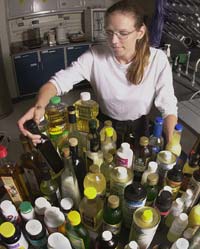Purdue food scientists improve testing of health supplements

Lisa Mauer’s research lab at Purdue University has tested a variety of oils for purity – from cod liver to vegetable and every imaginable oil in between. Mauer and her research team used infrared spectroscopy and statistical analysis to classify samples of dietary supplement oils, as well as common food oils. (Agricultural Communications photo/Tom Campbell) <br>
Purdue University researchers have discovered a faster, less expensive method to test the quality and purity of dietary supplement oils, such as flax seed, borage seed and grape seed oil, often touted as cures for many human maladies.
The research results are published in the September issue of the Journal of Agricultural and Food Chemistry and on the journal’s Web site.
“This study brings analytical chemistry, food science, nutritional sciences and consumer interest together,” said Lisa Mauer, assistant professor of food science. “Consumers want the salad dressing brand they buy to taste the same every time. The same is true for special types of oils, which are more expensive than a general cooking oil. You expect what you buy to be high quality and contain what is on the label.”
Consumers are concerned about purity because of taste, safety, health benefits and cost, she said. While oils that are less pure may be less expensive, they may lose the flavor or health benefits, and some can even be detrimental to health. In addition, consumer demand for food and food additives is increasingly for organic or 100 percent natural products.
Manufacturers of health supplements and drugs are concerned with purity because of quality control issues that impact safety of the substances and company economics.
To address these concerns, scientists search for fast, effective, inexpensive ways of differentiating between different ingredients – in this case dietary supplement oils.
Purdue researchers used infrared spectroscopy and statistical analysis to classify samples of 14 dietary supplement oils and five common food oils. The scientists profiled the chemical makeup of at least two different brands of each.
First, pure oil samples were tested to determine how well the spectroscopy method, called Fourier-transform infrared spectroscopy (FT-IR), could differentiate between each one. Then they mixed various amounts of each cooking oil with one of the dietary oils and tested to determine if FT-IR could identify the amounts of individual oils in the compounds.
FT-IR uses wavelengths of light to identify types of chemical bonds. Each type of molecule absorbs light differently, producing a spectrum. Scientists use this spectral information to identify the compound, much the way a fingerprint can identify a person.
“We wanted to see how good FT-IR and common chemical measurement analyses are at differentiating real-world whole samples instead of just one component,” Mauer said. “This is the first time this method has been used to differentiate a whole spectrum of food samples, such as the 19 oils used in the study, instead of only comparing two sample types.”
Conventional methods for ensuring the makeup of dietary and special use oils are time-consuming, she said. They involve multiple preparation steps and analysis, which take as much as several hours, after the sample preparation and initial analysis are complete. This painstaking process makes traditional purity tests expensive. The FT-IR method took only five minutes once the analytical procedure had been developed.
Many food and pharmaceutical companies already own FT-IR equipment, so there would be no additional cost of using the new purity testing.
In their research, the Purdue scientists tested oil mixtures that had 2 percent to 20 percent by volume of common food oils.
The researchers found that the FT-IR method could identify the adulteration down to 2 percent. They picked this range because food manufacturers have said those are the levels they need to know for quality control of oil mixtures, Mauer said.
The dietary supplement oils tested were almond, apricot kernel, black currant, borage, cod liver, evening primrose, flax seed, grape seed, hazelnut, hemp seed, macadamia nut, olive, pumpkin seed and wheat germ oils. The common food oils were canola, corn, peanut, soybean and sunflower.
Though they didn’t test for adulteration levels of oils that would cause allergic reactions in people, such as those allergic to peanut products, Mauer said the study indicated that the method likely could detect lower levels of various oils. Other studies have shown that FT-IR can be used to identify the region where the oil-producing plant was grown and the variety of plant from which it came.
“It’s interesting to see that some of the oils, such as canola oil and pumpkin seed oil or hazelnut oil and olive oil, are structurally so similar,” Mauer said. “It’s based on the fatty acid composition. But while you see dietary claims related to pumpkin seed oil, I don’t know of any canola oil being sold in capsules for health purposes.”
The other researchers involved with this study were Banu Ozen, postdoctoral fellow, and Ilan Weiss, graduate research assistant, both of the Department of Food Science.
The Purdue University Agricultural Research Programs provided funding for this research.
Writer: Susan A. Steeves, (765) 496-7481, ssteeves@purdue.edu
Source: Lisa Mauer, (765) 494-9111, mauer@foodsci.purdue.edu
Ag Communications: (765) 494-2722; Beth Forbes, bforbes@aes.purdue.edu;
Media Contact
All latest news from the category: Agricultural and Forestry Science
Newest articles

Superradiant atoms could push the boundaries of how precisely time can be measured
Superradiant atoms can help us measure time more precisely than ever. In a new study, researchers from the University of Copenhagen present a new method for measuring the time interval,…

Ion thermoelectric conversion devices for near room temperature
The electrode sheet of the thermoelectric device consists of ionic hydrogel, which is sandwiched between the electrodes to form, and the Prussian blue on the electrode undergoes a redox reaction…

Zap Energy achieves 37-million-degree temperatures in a compact device
New publication reports record electron temperatures for a small-scale, sheared-flow-stabilized Z-pinch fusion device. In the nine decades since humans first produced fusion reactions, only a few fusion technologies have demonstrated…





















